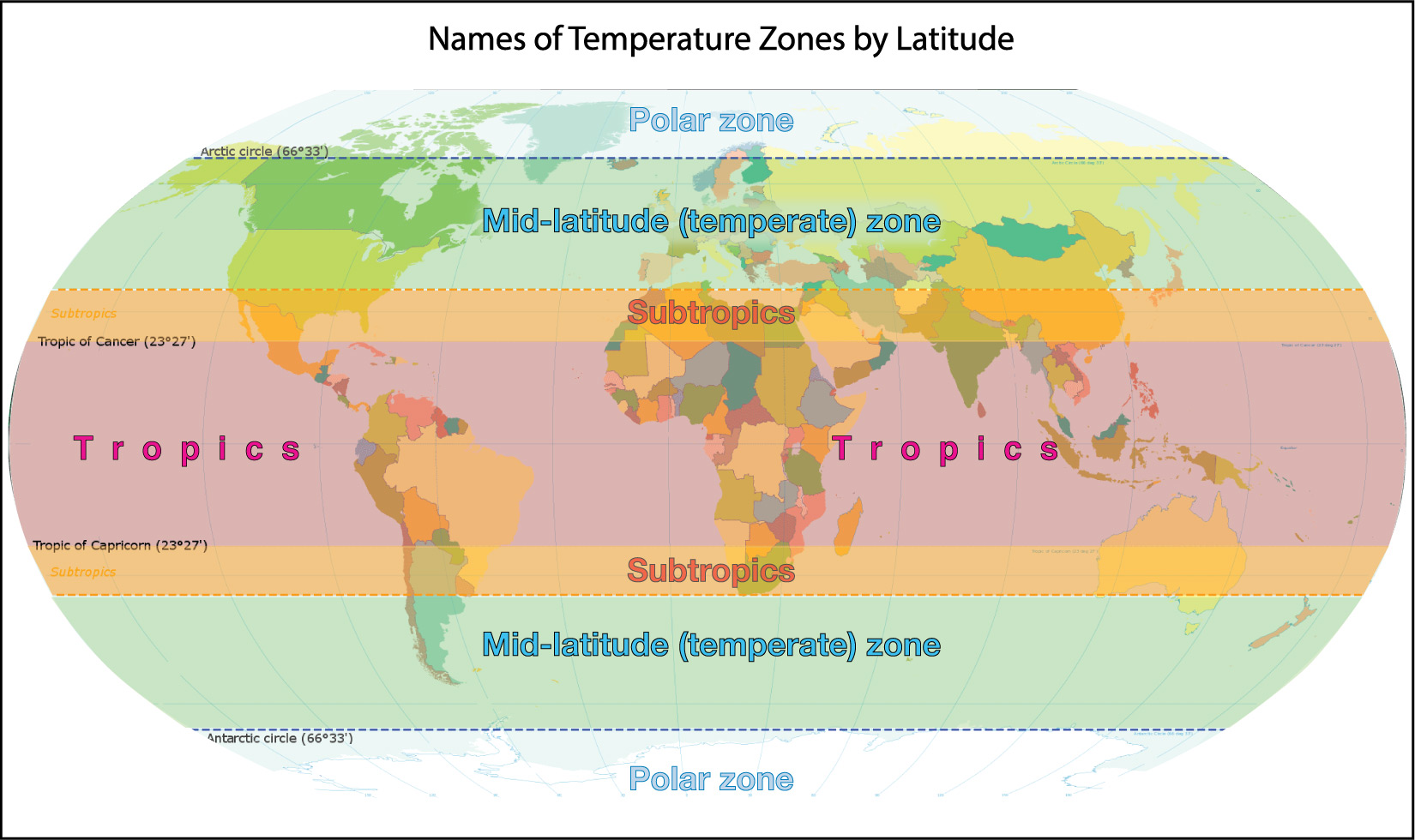
The Latitude Zone is a fascinating geographical concept that plays a crucial role in our understanding of the Earth’s climate, ecosystems, and navigation systems. It refers to the imaginary lines that run parallel to the Equator and divide the Earth into different climatic regions. The Latitude Zone is defined by the degrees of latitude, which measure the distance from the Equator.
In this article, we will explore 19 astonishing facts about the Latitude Zone. From the diverse wildlife that thrives in each zone to the impact of latitude on temperature and weather patterns, there is so much to discover about this fundamental geographic construct. So, let’s delve into these intriguing facts and deepen our understanding of the Latitude Zone.
Key Takeaways:
- The latitude zone, an imaginary line around the Earth, influences climate, daylight, and ecosystems, shaping our planet’s diverse natural wonders and human activities.
- Latitude zones impact everything from time zones to animal migrations, providing valuable data for climate change studies and showcasing the interconnectedness of Earth’s physical features.
The latitude zone is an imaginary line around the Earth.
The latitude zone, also known as the circle of latitude, is an imaginary line that runs parallel to the Equator. It helps us understand and define the Earth’s climate, weather patterns, and geographical features.
The Equator divides the Earth into the Northern and Southern Hemisphere.
The Equator, located at 0 degrees latitude, divides the Earth into two halves: the Northern Hemisphere and the Southern Hemisphere. This division plays a crucial role in determining the climate and seasons experienced in different parts of the world.
There are a total of 180 latitude zones.
Since the Earth is divided into 360 degrees of longitude, there are 180 latitude zones, both north and south of the Equator. These zones help us locate specific places on the globe and understand their position relative to the Equator.
The Tropic of Cancer and the Tropic of Capricorn are important latitude zones.
Located at approximately 23.5 degrees north and south of the Equator, respectively, the Tropic of Cancer and the Tropic of Capricorn mark the boundaries of the tropical climate zone. These zones are known for their hot and humid weather conditions.
The Arctic Circle and the Antarctic Circle are latitude zones of extreme cold.
The Arctic Circle, approximately 66.5 degrees north of the Equator, and the Antarctic Circle, approximately 66.5 degrees south of the Equator, are latitude zones characterized by extreme cold temperatures. These regions are home to polar ice caps and unique ecosystems.
The latitude zone impacts the length of daylight hours.
As one moves away from the Equator towards the poles, the length of daylight hours changes. In the polar regions, there are periods of continuous daylight during summer and continuous darkness during winter, while near the Equator, the length of daylight remains relatively consistent throughout the year.
The latitude zone affects climate diversity.
The latitude and corresponding distance from the Equator play a significant role in determining the climate of a specific region. Areas near the Equator experience a tropical climate, while those closer to the poles have more temperate, subarctic, or polar climates.
Latitude zones impact the distribution of plant and animal species.
Due to variations in temperature and daylight, different latitude zones support unique ecosystems and influence the distribution of plant and animal species. Tropical rainforests thrive near the Equator, while tundra landscapes dominate the polar regions.
The latitude zone affects agricultural practices.
Farmers and agricultural practices vary across latitude zones due to differences in climate and growing seasons. Crops suited for a tropical climate, such as bananas and pineapples, are grown in regions near the Equator, while cooler regions specialize in crops like wheat and barley.
The latitude zone influences the availability of solar energy.
Regions closer to the Equator receive more direct sunlight throughout the year, making them prime locations for solar energy utilization. Countries located within the latitude zone often have extensive solar energy infrastructure.
Latitude zones impact time zones.
Time zones are closely related to the position on the Earth’s longitude and latitude lines. As one moves east or west within a latitude zone, time changes, leading to the establishment of different time zones around the world.
The latitude zone affects the behavior of ocean currents.
Latitude plays a role in determining the direction and intensity of ocean currents. Warm ocean currents flow from the tropics towards higher latitudes, influencing the climate of coastal regions and impacting marine life distribution.
The Antarctic Circle experiences the phenomenon of the midnight sun.
During the Antarctic summer, areas within the Antarctic Circle experience the phenomenon of the midnight sun. This means that the sun remains visible for the entire 24-hour period, resulting in continuous daylight.
The latitude zone affects the occurrence of auroras.
Regions near the poles, such as the Arctic and Antarctic Circles, have a higher probability of witnessing auroras, also known as the Northern and Southern Lights. These natural light displays occur when charged particles from the sun interact with the Earth’s magnetic field.
The latitude zone impacts the location of deserts.
Many deserts are located near specific latitude zones. The Sahara Desert in Africa and the Mojave Desert in North America are examples of deserts that lie close to the Tropic of Cancer, experiencing high temperatures and arid conditions.
Latitude zones affect the migration patterns of animals.
Many animal species, especially birds, migrate across latitude zones to take advantage of seasonal climate and food availability. These impressive journeys often span thousands of miles and require precise navigation skills.
The latitude zone determines the angle of the Sun’s rays.
The angle at which the Sun’s rays hit the Earth varies based on latitude. In lower latitudes, such as near the Equator, the Sun is more directly overhead, resulting in higher temperatures and stronger sunlight.
The latitude zone impacts human cultural practices.
Latitude zones can influence human cultural practices and traditions. Different regions have unique festivals, clothing styles, culinary preferences, and architectural designs that are shaped by their climate and geographical location.
The latitude zone provides valuable data for climate change studies.
Latitude zones and their associated climates provide scientists with essential data for studying and monitoring climate change. Monitoring shifts in temperature, ice melting, and ecosystem shifts across latitude zones helps track the impact of global warming.
Conclusion
In conclusion, the latitude zone is a fascinating area of study that impacts our understanding of the Earth’s climate, weather patterns, and ecosystems. It plays a crucial role in determining the distribution of temperature and sunlight across the globe. The diverse range of climates found within the latitude zones contributes to the incredible variety of landscapes and habitats on our planet.Understanding the latitude zone is essential for a wide range of applications, including agriculture, urban planning, and tourism. By studying the latitude zones, we can better comprehend the factors influencing climate change and take steps to mitigate its impact.From the frozen tundra of the Arctic Circle to the tropical rainforests of the equator, the latitude zones hold a wealth of astonishing facts waiting to be discovered. So the next time you find yourself traveling or exploring, remember the fascinating influence that latitude has on our world.
FAQs
Q: What is the latitude zone?
A: The latitude zone refers to the area between the Tropic of Cancer and the Tropic of Capricorn, which includes the equator and the regions nearby.
Q: How does latitude affect climate?
A: Latitude plays a significant role in determining climate as it affects the amount of sunlight received, which in turn impacts temperature and weather patterns.
Q: What are the different climate zones within the latitude zone?
A: The latitude zone consists of three primary climate zones: the tropical zone near the equator, the temperate zone between the tropics and the polar circles, and the polar zone near the poles.
Q: What are some examples of natural features influenced by latitude?
A: Some natural features influenced by latitude include the presence of rainforests near the equator, the formation of the polar ice caps near the poles, and the prevalence of deserts in certain latitudes.
Q: How does latitude impact the length of daylight?
A: Latitude directly affects the length of daylight. Closer to the poles, daylight hours are longer during summer and shorter during winter, while at the equator, daylight hours remain relatively consistent throughout the year.
Q: Why is understanding latitude important?
A: Understanding latitude is crucial for a variety of reasons, including navigation, agriculture, and climate research. It helps us locate places on Earth, predict weather patterns, and study the impact of climate change.
Was this page helpful?
Our commitment to delivering trustworthy and engaging content is at the heart of what we do. Each fact on our site is contributed by real users like you, bringing a wealth of diverse insights and information. To ensure the highest standards of accuracy and reliability, our dedicated editors meticulously review each submission. This process guarantees that the facts we share are not only fascinating but also credible. Trust in our commitment to quality and authenticity as you explore and learn with us.


